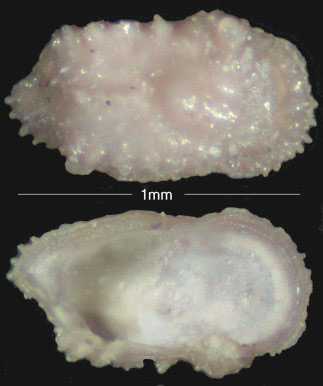Ostracods
Ostracods are a class of the phylum Crustacea. They
are shrimp-like arthropods living in a carapace
comprising two oval valves hinged at the upper,
dorsal, margin. They have seven pairs of appendages,
and the valves open just a few degrees to allow
appendages to protrude for walking, swimming or
feeding. They occur both as fossils and as living
creatures. They are very small, the carapace being
typically of the order of one millimetre long. They
are aquatic; being found in fresh, marine and
brackish waters. They have even been found in damp
woodland conditions. They mature by shedding their
carapace and producing a new larger one into which
they grow. Study of the size of Ostracods of the same
species shows that the sizes are grouped, indicating
that they pass through eight instars before reaching
full adult size. The taxonomy of modern Ostracods
uses information on the appendages. However, with a
few exceptions, these soft parts do not survive the
fossilization process. The taxonomy of fossil
Ostracods therefore has to be based on the only part
that survives, namely the Calcite valve or
occasionally a complete carapace. Fresh water Ostracods usually have a smooth valve but marine Ostracods mostly have a sculptured valve. The sculpting is one of the major features for distinguishing species and may include pits and/or reticulation. Conversely, the sculpting may be raised in the form of pips, ridges or even wing-like extensions of the ventral margin. The valve of some species has a transparent eye lens, while other species have a rostrum (a beak-like extension). Some valves have a rounded, oval, shape while others are more rectangular. The aspect ratio of the valve (the ratio of its length to height) is also a distinguishing feature. The dorsal hinge may be simple, comprising a straight bar on one valve locating into a socket on the other valve, or complex. Complex hinges have teeth and sockets. In some cases, internal valve characteristics may be necessary to distinguish between superfamilies. These include a chitinous lamella on the inner free border that has been calcified to form a duplicature, and muscle scars where the soft parts of the creature have been attached to the valve. The picture shows a nice specimen of Cythereis folkestonensis |